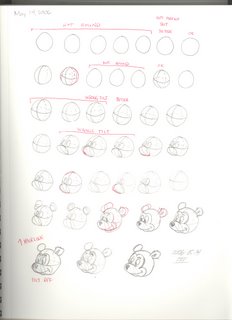The $100,000 Animation Drawing Course- Lesson 1
I thought I'd post-pone the learning of electronic graphics tools for a bit. John Kricfalusi is offering to walk folks through the Preston Blair Animation Classic. How could I pass up an opportunity like that?
I'm a little out of John's target age range of 10 - 24 years. So it's going to take me a little longer to break some bad habits, learn new habits and find the time to get the lessons in. John's already on Lesson Three. I've just completed the first part of Lesson One. I think there are 3 more discrete parts to Lesson One. This could take a while.
So here's my assignment for Lesson One, Part One. Sadly, it's the 20th such sheet like this. You should see the first sheets! Thanks to Mr. Kricfalusi and Mr. Worth for offering the lessons and the valuable feedback.
(clicking on image will enlarge, clicking on enlarged image will allow you to enlarge again [in IE and Firefox])
Notes:
From Stephen Worth:
1. "If you just look at the drawings and read the text, you'll end up with educated eyes and an educated mind... and ignorant hands. A lot of artists excuse their lack of skill by claiming that flat drawings and unappealing shapes are their "style". Poor drawing skills don't constitute a style. "
2. "I would recommend using paper and pencil at first. Drawing a perfect curve, like the one on an egg is difficult enough with a paper and pencil. Adding the separate layer of the wacom tablet is just going to slow down your progress and frustrate you.
Instead of trying to draw with fast sweeps, take your time and really focus on getting the construction shapes absolutely perfect. You need to draw hundreds and hundreds of eggs to get your hand used to drawing exactly what your mind is telling it to... Once you become adept with the pencil, THEN pick up the wacom and train yourself to get used to it. That way, you'll learn one thing at a time. "
From John K:
1. "Use tyracing paper to trace the construction off of Preston's drawings then lay
the tracing paper over your drawings to see where you are off.Write notes of the mistakes.
Then redraw the same drawing again, trying to fix the mistakes. "




No comments:
Post a Comment